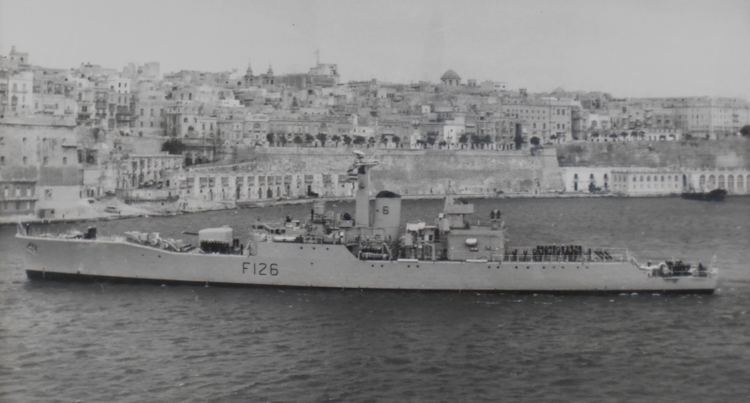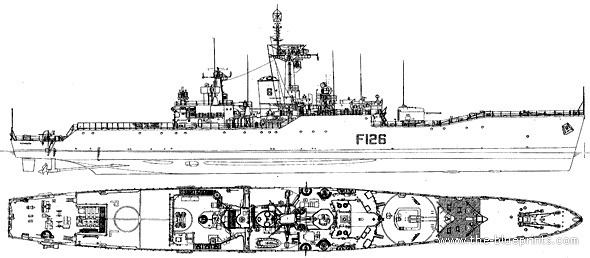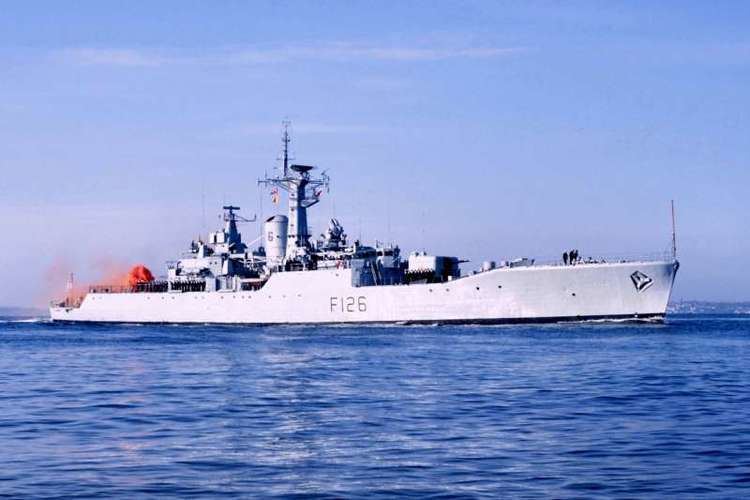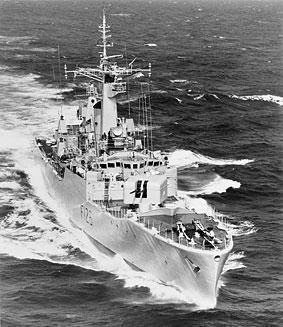Name HMS Plymouth Commissioned 11 May 1961 Construction started 1 July 1958 Length 113 m Builder HMNB Devonport | Laid down 1 July 1958 Decommissioned 28 April 1988 Fate Scrapped October 2014 Launched 20 July 1959 Draft 5.27 m | |
 | ||
Similar HMS Onyx, HMS Bronington, Great Float, HMNB Portsmouth, HMS Cavalier | ||
HMS Plymouth was a Royal Navy Rothesay-class frigate. Named after the English city of Plymouth, she was commissioned in 1959. Plymouth was one of 12 ships built in the new Rothesay class; which began replacing the ageing Whitby (Type 12s) in the mid 1950s. During active service in the Cold War, the ship was sent to the Far East and Australia where she was the lead vessel in several squadrons. In 1982, Plymouth was one of the first Royal Navy ships to arrive in the South Atlantic during the Falklands War. She was decommissioned in 1988.
Contents

After the warship was paid off, Plymouth was set aside as a preserved vessel. Throughout the 1990s she was opened to the public at various ports throughout the United Kingdom. The final mooring was at Birkenhead where she became the undertaking of Peel Holdings. A preservation society - established to save Plymouth - accused the company of deliberately allowing the ship's condition to deteriorate. Despite several attempts to raise money to turn the former warship into a museum ship, Peel Ports sold Plymouth for scrap. She was towed to Turkey for dismantling on 20 August 2014, and had been scrapped by the end of the year.

History

Plymouth was built at the Devonport Dockyard, in her namesake city of Plymouth. She was launched by Viscountess Astor on 20 July 1959.
Cold War

Plymouth served between 1963 and 1964 as the leader of the 22nd Escort Squadron and leader of the 29th Escort Squadron from 1964 to 1966 in Singapore and Australia.
In 1970 Plymouth took part in the Cook Bicentennial celebrations held in Sydney Harbour. After a spell inside a floating dock in Singapore, to clean and repaint her hull, the ship sailed across the Indian Ocean for a six-week stint on the Beira Patrol.
Back in the UK, Plymouth visited various ports around the country including Stornoway and Middlesbrough as part of a Royal Navy recruitment drive.
In 1977 the ship - as part of the 8th Frigate Squadron - attended the Fleet Review off Spithead for the Queen's Silver Jubilee. She saw action in the Cod Wars between the United Kingdom and Iceland and also the Falklands War in 1982.
Falklands War
Plymouth was one of the first Royal Navy ships to arrive in the South Atlantic following the Argentine invasion of the Falkland Islands and South Georgia. She, alongside Antrim, Brilliant and Endurance took part in the recapturing of South Georgia on 28 April during Operation Paraquet. Plymouth landed Royal Marines from her Westland Wasp helicopters and bombarded Argentine troop positions on the island. Her Wasp helicopter later took part in an attack on the Argentinian submarine Santa Fe, which was badly damaged and later captured by Royal Marines.
Plymouth rejoined the task force and supported troops on the ground by bombarding Argentine troop positions with her 4.5-inch (114 mm) guns.
On 8 June, Plymouth was attacked by IAI Nesher fighter bombers of FAA Grupo 6 of the Argentine Air Force. Plymouth was hit by four bombs and several cannon shells. One bomb hit the flight deck, detonating a depth charge and starting a fire, one went straight through her funnel and two more destroyed her Limbo anti-submarine mortar. MEM's John Fearon, David Rance, Gary Borthwick, Robin Cunningham, Alan Harsent, Ray Potts and Kevin Gallagher were part of the damage control and fire fighting teams crucial to saving the ship. All of the bombs failed to explode. Five men were injured in the attack.
Plymouth's wardroom was where the surrender of Argentine Forces in South Georgia was signed by Lieutenant commander Alfredo Astiz. The ship returned to Rosyth Dockyard after the war for full repair and a refit.
Final years and preservation
The following year, Plymouth served as the West Indies guard ship. On 11 April 1984, she was involved in a collision with the German Köln-class frigate Braunschweig. In 1986 she suffered a boiler room fire, killing two sailors.
After the ship, which was the last Type 12 in service, was paid off on 28 April 1988, she was acquired by the Warship Preservation Trust. In 1990 she was towed to Glasgow and placed on permanent display at a berth on the River Clyde. In the late 1990s, she was relocated to the Great Float - within Birkenhead Docks - for display alongside other preserved ships and submarines.
Scrapping controversy
On 6 February 2006 the Warship Preservation Trust closed citing financial difficulties. Plymouth became the property of the Mersey Docks and Harbour Company following the demise of the trust. Plymouth City Council expressed an interest in the ship; a campaign group called the HMS Plymouth Preservation Trust attempted to raise £250,000 to bring the warship back to her home city. However the attempt to bring the Type 12 frigate back to Plymouth's Millbay Docks failed after the Associated British Ports withdrew the offer of a berth in January 2007. An online petition then called on the UK government to provide a berth for the ship, but it was announced in 2012 that she has been sold for scrapping.
In January 2014 campaigners continued to dispute Peel Ports - which owns Mersey Docks - that it had ownership rights to Plymouth. The action group accused Peel of allowing the condition of Plymouth to worsen in order to make any attempt to move/preserve her appear unfeasible. The ship was towed from Vittoria Dock, Birkenhead, by the tug Amber II, on 20 August 2014 to be scrapped in Turkey. HMS Plymouth was scrapped at Aliaga in 2014. There appears to be some controversy about how the sale was conducted by The Peel Group and some of the clauses included in the sale contract with the dismantlers.
It is widely rumoured that one of the Royal Navy's new Type 26 frigates, due to enter service in 2020, will be named Plymouth in recognition of the city of Plymouth's continuous contribution to the UK's defences.
